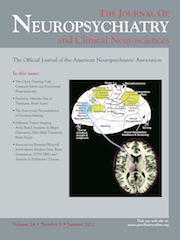We Are All Zombies Anyway: Aggression in Cotard's Syndrome
To the Editor: Cotard’s syndrome is an infrequent condition with monothematic, nihilistic delusions. The delusion of being dead is common, but delusions of immortality can also be present.1 Patients tend to act according to their belief and so are at an increased risk of self-mutilation and suicide.2 In theory, Cotard’s syndrome could also lead to a lower threshold for violence against others, but no such case has been reported. We provide first evidence of Cotard’s syndrome resulting in repeated aggressive behavior.
Case Report
"Mr. H.," a 32-year-old patient, was involuntarily admitted to our closed ward in February 2011. He had been diagnosed with paranoid schizophrenia and cannabis abuse at the age of 22, when he had been taken into police custody after a fight with his neighbors. In the following years, multiple involuntary admissions were necessary. After clozapine treatment had been started and a legal custodian was installed, the frequency of intimidating and hostile behavior could be reduced. The current hospitalization had become necessary after the patient had been reluctant to continue medication and had again started showing violent behavior.
During psychopathological examination, we saw an agitated, suspicious patient with severely affected formal thinking. He reported being dead since he had drowned in a lake years before, and said that he had been reanimated as a zombie by radiation from mobile telephones. He was under the impression that he was still under water, and that everybody else had also drowned and become a zombie. The patient explained that although it was morally wrong to exert violence on living persons, there was nothing wrong with beating up zombies. He wasn’t afraid of retaliation or legal prosecution, because he believed himself to be dead and to have no feelings.
After acute treatment with orally administered haloperidol and diazepam and injections of zuclopenthixol, clozapine treatment could be resumed. Delusions of being dead decreased in intensity, and the patient became less intimidating and hostile. By the time of dismissal, the patient showed no aggressive behavior.
Discussion
For our patient, there were no records of aggressive behavior before the onset of schizophrenia, and his clinical file documented that he had frequently committed aggressive acts afterward, and multiple episodes of involuntary treatment and physical restraint had become necessary. The patient repeatedly used the belief that he and all persons were zombies as justification for his violent behavior. This is in line with the literature, as acting because of a belief is a typical criterion for severe delusions, and has been found to be associated with violent crime in delusional patients.3 Thus, Cotard’s syndrome in our patient can be seen as a condition facilitating aggressive behavior.
We therefore suggest critical assessment the risk of violent behavior in patients with delusions justifying aggression. Nevertheless, dangerousness has to be constantly re-evaluated to avoid stigmatization and unjustified retention in the penal system.4
1 : Cotard syndrome in neurological and psychiatric patients. J Neuropsychiatry Clin Neurosci 2010; 22:409–416Link, Google Scholar
2 : Cotard’s syndrome: a review. Curr Psychiatry Rep 2009; 11:197–202Crossref, Medline, Google Scholar
3 : Violent crime and dimensions of delusion: a comparative study of criminal and noncriminal delusional patients. J Am Acad Psychiatry Law 2009; 37:225–231Medline, Google Scholar
4 : Deep concern. Schizophr Bull 2010; 36:437–439Crossref, Medline, Google Scholar



